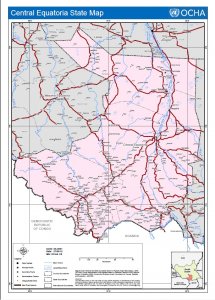- Population: 1,103,592

- State capital: Juba
- Internally Displaced People (IDP) sheltering in the state: 59,500
Central Equatoria State is the smallest state in South Sudan, but with the second highest population. The capital, Juba, is located in the state which has been a political and military battleground during the current conflict.
The first signs of the violent conflict in South Sudan started in Juba 15 December when fighting broke out in a military garrison in the city. The following day, violence spread to Bilpam, the military headquarter outside Juba, and to residential areas. Leading opposition politicians within the SPLM were rounded up and the residence of the former vice-president, Riek Machar, was attacked by government forces. House searches, violence and looting were reported the following days. The victims were often civilians and by 18 December 8,500 people had sought refuge at the Tomping UNMISS site. The violence in Juba decreased by the end of December, but in March there were new incidents of violence. Clashes also took place outside of Juba. In the north (Mangalla and Terekeka) and south-west (along the Juba-Yei road) of the city people were forced to flee. In Yei, there was fighting within the military barracks.
Greater Equatoria (consisting of Eastern, Western and Central Equatoria States) has been politically divided on the issue of federalism. This is however more a question of strategy rather than goal, because there is no doubt that ideas of devolution of powers and decentralisation of government powers are widely supported in Central Equatoria. The Greater Equatoria Council of Rights announced support for SPLM/A-in-Opposition (SPLM/AiO), but other politicians made it clear that this organisation does not speak on behalf of the region and that they remain loyal to the current government. The recent parliament approval of the establishment of five new counties in Central Equatoria might be seen as a part of this debate. This decision was a confirmation of a directive from Salva Kiir and might indicate that the current SPLM leadership uses governance reform to reward loyalty.
The conflict has forced more than 1.7 million people in South Sudan to leave their homes. This has not only created a difficult situation for those on the move, but also for the communities receiving people. In Central Equatoria, the state governor has complained that cattle keeping groups arriving from Jonglei disrupt farming and threaten local security. The UN has struggled to protect the IDPs searching refuge in Juba. At the moment 29,306 people are sheltered in the Tomping camp and the UN base. The conditions in these camps rapidly deteriorated with the rainy season. The Tomping camp was flooded in April and an additional camp had to be established to take the pressure of the overcrowded areas. The total of IDPs sheltering in the state decreased over the summer, but this seems to be the result of people crossing the border to Uganda, more than of people returning to their homes.
Leave a Reply